Three Agricultural Spray Drone Models That Promise to Be Breakthroughs (Part One)
Editor’s note: Part One of this three-part series on agricultural spraying drones features ADAMA/Tactical Robotics. Be sure to also check out Part Two (Bayer CropScience) and Part Three (Rantizo).
Drone technology in agriculture has moved rapidly though the technology hype sequence, from curiosity to irrational exuberance to overblown misfit. In reality, drones at first were a solution in search of a problem, and the recalibration and emerging rebirth is exactly what the drone industry has needed.
A compelling aspect of this rebirth is the use of drones for spray application. What seemed far-fetched a few years ago is now being embraced by some prominent players among drone companies and crop protection manufacturers, resulting in partnerships that are moving the needle on drone-applied inputs.
Currently, and to the best of our knowledge, there are three entities – consumer drone giant DJI’s Agras MG-1P not withstanding – that are driving spray drone research and development in row crop farming: ADAMA via its recently announced partnership with Israel-based Tactical Robotics, Bayer’s CropScience Division and its efforts in China and Japan on small-holder farms, and Rantizo (a seven-employee startup out of Iowa City, Iowa, U.S.).
MORE BY MATTHEW J. GRASSI
VISION Conference Preview: Someday, AI Might Grow Better Plants than People
2019 Commercial UAV Expo: 3 Quick Revelations From an Ag Drone Expert
Specialty Crops: 8 More Precision Technology Companies We’re Keeping an Eye On
Representatives from each company shared some details about their business approaches, use of technologies, and view on the future of drone application in ag. Here’s a look at ADAMA/Tactical Robotics. Be sure to also check out Part Two (Bayer) and Part Three (Rantizo).
ADAMA + Tactical Robotics
In March, ADAMA, in Tel Aviv, Israel, announced the undertaking of a joint feasibility study with Tel-Aviv-based neighbor and drone innovator Tactical Robotics on high-payload unmanned aerial vehicles (UAVs) for aerial crop spraying.
Dani Harari, SVP Strategy & Resources, ADAMA, says that the first feasibility flight, in which Tactical outfitted its high-payload UAV with spray booms and did a test spray with water, is in the books. The company will shift to looking at different agronomic considerations, such as what heights are best for applying products to crops, and whether the military-grade drone Tactical is using provides any sort of drift-reduction benefits compared to ground-rig application.
“First of all, we did computer simulations to check the Ag-Cormorant’s potential and saw it can fly in every air speed that is required by the operator,” Harari says. “As far as drift is concerned, we can adjust spraying height, and use the unique downwash effect to reduce drift and improve coverage.”
Harari says that ADAMA’s approach – partnering with Tactical Robotics and using its Ag-Cormorant high-payload (500 KG), vertical-takeoff bi-rotor drone – sets it apart from other developers in the space.
“To my knowledge, there is no similar UAV spraying platform with this kind of payload capabilities available at the moment,” Harari says. “Published initiatives, with DJI for example, are focused on significantly lower payload capabilities (i.e., under 55 lbs.) and adjuvants for drift reduction, using small drones. We’re talking about totally different things.”
Harari points to Tactical’s log of more than 300 successful flights and its ability to spot spray a field with the Ag-Cormorant as additional differentiating points among its rivals.
“It’s the future of aerial spraying,” Harari says. “In the U.S. alone about 20% of the spraying is aerial. I believe that there are a lot of advantages for this kind of platform, especially when combined with ADAMA’s R&D and formulation capabilities. Both companies together will create a whole solution, which will be customizable and adjusted for various crop protection applications.”
Harari says the company is currently targeting what they consider the big markets for aerial drone spraying – the U.S., Brazil, Argentina, Australia, and Canada.
Drone-based application would serve to shore up the depleted ranks of aerial application pilots and provide an overnight application window when pilots are not able to fly. “Application timing is an important factor, and the best time to spray is mostly when it is still too dark for the pilots to take off,” says Harari. “An unmanned aircraft can enable spraying in better conditions for reducing drift.”
Another important factor is the Ag-Cormorant’s vertical-take-off-and-landing capability, which reduces turnover time and increases productivity, he notes. “Today, pilots fly back and forth to the airfield – the Ag-Cormorant does not need an airfield, and it does not need to fly from the airfield to the field with a tank full of chemicals, which makes it much safer to use. I believe our UAV sprayer can compete successfully with the manned aerial sprayers or even the big ground tractors.”
Currently, U.S. FAA’s Part 107 and its current regulatory structure makes testing such a high-payload spray drone here in the states virtually impossible. But Harari is optimistic that both the passage of time and the public growing more comfortable with drone technology will hasten the adoption of spray drone technology on U.S. crop land.
“The technology is already there,” he allows. “Part 107 came after drones were almost everywhere already, and I believe that new regulations will adapt to the technological development. It might take three years or five years, perhaps less.
“If there is going to be technology that proves this is much better for the environment, for growers, for applicators, for the whole industry, then there might be an incentive for the regulators to allow higher payload in unmanned flights,” he continues. “We see the potential use of autonomous UAVs in other industries, like what Uber and Tesla are working on, so the need for regulation adaptation might come from this angle as well.”
Be sure to also check out Part Two (Bayer) and Part Three (Rantizo).











